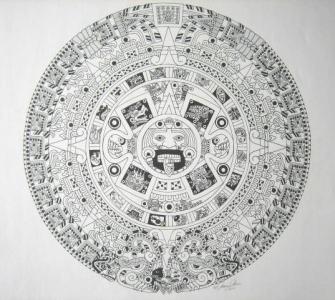WHI-Chap6/21-Aztecs
The Aztecs originally referred to themselves as the Mexica. The Mexica arrived in central Mexico around the mid-13th century. They did not immediately settle, instead they wandered around for a century building up a reputation for kidnapping their neighbors' women and taking land already cultivated by others. In 1345 the Mexica settled on an island in the middle of Lake Texcoco, creating a settlement that would eventually be called Tenochtitlan. The lake offered a food and water source, and also protection from invaders. The Aztecs used the effective chinampa system for agriculture and prospered in Tenochtitlan.

By the 15th century the Mexica were powerful enough to expand their realm, overtaking their neighbors and demanding tribute from their new subjects. In the mid-15th century the Aztecs created a triple alliance with Texcoco and Tlacopan. The Aztec empire had no elaborate bureaucracy or administration, nor did they have a standing army, or garrisons throughout the empire. They simply ruled through fear. As long as the people feared their power in battle, they had few problems with obedience.
 Aztec Calendar
Aztec Calendar
Mexica society was rigidly hierarchal, the military elite receiving most of the public honors and rewards. In this blatantly patriarchal society women had almost no role in public affairs. All women, except those dedicated to the service of a temple, were married, and were taught that their primary function was to bear children. Priests were among the aristocracy of the Mexica. They received a special education in calendrical and ritual lore, and they presided over religious ceremonies that were of the utmost importance in the continuance of the world. The Mexica also had calipulli, groups of families claiming descent from common ancestors. They lived together in communities, organized their own affairs, and allocated community property to individual families. Aztec society included a large number of slaves who usually worked as servants. Slaves were not foreigners, but poverty-stricken individuals or criminals. Skilled artisans enjoyed considerable prestige in Aztec society but long distance merchants had a much more tenuous position.

The Aztecs shared many cultural and religious icons with the Olmecs including the ball game, a calendar (though it was less complex), and two of their principle gods, Tezcatlipoca and Quetzalcóatl. The Mexica practiced ritual bloodletting to keep their agricultural society going. They also practiced human sacrifice, a ritual that most Mesoamerican peoples thought essential to the continuation of the world.
The Aztecs downfall came with the Spanish explorers in 1519.
T&E p. 541-548